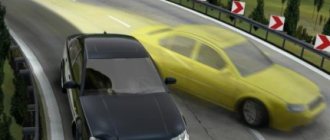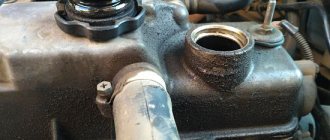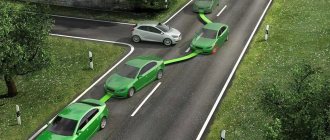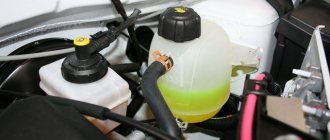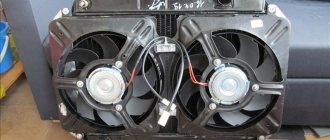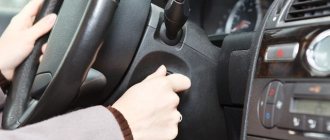Most drivers of modern cars equipped with various electronic security systems prefer not to delve into their essence and design. Of course, all of them have once heard such abbreviations as ABS, ASR or ESP, or seen the corresponding inscriptions on the car panel, but only a few know what they mean and why they are provided. Let's try to understand these systems, because it's not that difficult.
What is traction control system (ATS)?
APS is a set of useful active safety functions of the car, designed to ensure optimal traction of the wheels with the road surface. It simplifies vehicle control when starting, accelerating, braking and cornering. In addition, APS significantly helps the driver cope with control in slippery road conditions. The first traction control system was invented by American engineers and used in 1971 on Buick cars. In 1987, she developed an APS for Mercedes-Benz cars. But these were just mechanical prototypes of modern security features. And already in the 1990s, the ASR (Anti-Slip Regulation) traction control system appeared. This was already a full-fledged APS, consisting of a set of hydraulic mechanisms controlled by electronics.
ANTI-TRACTION SYSTEM HOW IT WORKS IN REAL CONDITIONS
Before further considering the implementation of the described principles, it is necessary to note the following factors necessary for the successful operation of the traction control system:
- the presence of devices such as ABS and ESP on the car;
- the presence of a so-called “electronic gas pedal”, i.e. lack of direct connection between the gas control pedal and the throttle valve.
In fact, this is ABS in reverse; if it removes braking from a wheel to ensure its grip on the road, then the traction control system slows down a wheel that is too “nimble” for the same purpose. And in their work they use the readings of the same sensors.
The traction control system is called differently - ASR or TRC, TCS (traction control system), and these abbreviations do not exhaust all the possible designations that the traction control system receives from different manufacturers. However, despite the different names, the principle by which any of them works is almost the same.
The sensors used by all these systems - ABS, ESP, TRS, ASR - are the same. In its simplest form, for example, the ASR traction control system receives signals from sensors, by which it determines:
- wheel speed (angular);
- their position (movement is straight or turning);
- the degree of wheel slip, based on the calculated difference in their angular speeds.
Based on the data obtained, depending on the speed of movement, the traction control system can:
- through a system of solenoid valves, change the pressure in the braking system, reducing the speed of rotation of the wheel;
- issue a signal to the engine control controller to reduce torque;
- change the amount of torque supplied to the slipping wheel through partial differential locking;
- take several marked actions at the same time.
What capabilities a particular traction control system TRC, TCS, ASR and others similar in purpose have, is determined primarily by the design of the car, as well as the software. However, despite the existing differences in implementation, the traction control system, regardless of the type - TRC or ASR, when it works, ensures confident acceleration of the car and reliable adhesion of the rubber to the road surface.
Titles
Depending on the manufacturer, the traction control system has the following trade names: ASR
(Automatic Slip Regulation, Acceleration Slip Regulation) on Mercedes, Volkswagen, Audi, etc. cars;
ASC
(Anti-Slip Control) on BMW cars;
A-TRAC
(Active Traction Control) on Toyota vehicles;
DSA
(Dynamic Safety) on Opel cars;
DTC
(Dynamic Traction Control) on BMW vehicles;
ETC
(Electronic Traction Control) on Range Rover vehicles;
ETS
(Electronic Traction System) on Mercedes cars;
STC
(System Traction Control) on Volvo cars;
TCS
(Traction Control System) on Honda cars;
TRC
(Traking Control) on Toyota cars. Despite the variety of names, the design and principle of operation of these traction control systems are largely similar, therefore they are considered using the example of one of the most common systems - the ASR system. The traction control system is built on the structural basis of the anti-lock braking system. The ASR system has two functions: electronic differential lock and engine torque control. To implement traction control functions, the system uses a reverse feed pump and additional solenoid valves (switching valve and high pressure valve) on each of the drive wheels in the ABS hydraulic unit. The ASR system is controlled by appropriate software included in the ABS control unit. In its operation, the ABS/ASR control unit interacts with the control unit of the engine management system.
Diagram of the ASR traction control system
(fig. below) 1 compensation tank 2 vacuum brake booster 3 brake pedal position sensor 4 brake pressure sensor 5 control unit 6 return pump 7 pressure accumulator 8 damping chamber 9 inlet valve of the front left brake mechanism 10 exhaust valve of the front left brake mechanism drive 11 inlet valve of the rear right brake mechanism drive 12 exhaust rear right brake drive valve 13 front right brake drive inlet valve 14 front right brake drive exhaust valve 15 rear left brake drive inlet valve 16 rear left brake drive exhaust valve 17 front left brake cylinder 18 front left wheel speed sensor 19 front right brake cylinder 20 frequency sensor rotation of the front right wheel 21 rear left brake cylinder 22 rear left wheel speed sensor 23 rear right brake cylinder 24 rear right wheel speed sensor 25 switching valve 26 high pressure valve 27 communication bus
Advantages and disadvantages
TCS is designed to automatically align the vehicle's trajectory in conditions of unevenly slippery road surfaces. It is relevant for drivers with little driving experience. TCS ensures: a uniform and straight start from a stationary vehicle on a slippery road surface; normal cornering; reduction of tire wear. Considering the peculiarities of the traction control system, it also has disadvantages: Mercedes-Benz GLE 2022
Recommended: Minimum brake pad thickness
reducing the performance of the power unit due to a forced reduction in torque; the possibility of creating “stalemate” situations when further movement of the car becomes impossible without slipping (for example, on a snow or mud track). Vehicles equipped with TCS usually have controls that disable its operation. These can be push-button or key switches or on-board control system options.
Common causes of malfunction
Increase engine compression AWS will help you increase engine compression in 30 minutes. aws-russia.ru Yandex.Direct The performance of the TCS traction control system directly depends on the serviceability of the ABS. The most common causes of failure: malfunction of one of the wheel rotation sensors; clogging of the wheel (comb) rotation speed tracking zone; violation of the integrity of the cables connecting the sensors to the control unit; failure of the ABS unit solenoid valves; ABS unit pump malfunction; blown fuses serving the control unit; CAN bus problems. Troubleshooting TCS begins with computer diagnostics.
After identifying the faulty sensor, assembly or component, they begin to eliminate the specific fault. After eliminating the malfunction, the error remains active on many vehicles. In order to remove the error, you need to perform a certain sequence of actions in dynamic mode (sea trials). This can be a car moving with successive turns and braking. For example, in a Mercedes Sprinter car, these are four consecutive left turns with braking.
ANTI-TRUCK SYSTEM ESP
A traction control system such as ESP deserves special attention. It is responsible for the directional stability of the car, preventing it from lateral sliding, skidding and rotation. If ABS works during braking, TRS and ASR during acceleration, then ESP works when turning and performing maneuvers. In fact, these elements of monitoring the current behavior of the machine create, if not completely safe, then conditions as close as possible to this.
During operation, ESP compares the driving direction specified by the driver with the actual one. All control is carried out based on signals from sensors dozens of times per second, practically the car is constantly under electronic control. If there is a discrepancy between the specified and actual direction of movement, i.e. sliding or skidding begins, ESP takes the necessary measures to eliminate it in a split second.
To do this, the traction control system reduces the speed of the car and applies the brakes to the necessary wheels, returning the car to the specified direction of travel.
Whether it is TCS or any other traction control system, they ensure the safety of the car and are used by their manufacturers more and more widely in cars of various classes. This approach allows many drivers, including experienced ones, to avoid critical situations when driving a vehicle.
Over the past few decades, cars have been actively equipped with various safety systems that can monitor the safety of vehicle acceleration and braking. Similar technologies are used in all modern vehicles .
They have come a long way - from the simplest to a whole complex of systems combined into traction systems.
The traction control system (ATS) is a secondary active safety element of the vehicle, working in conjunction with the ABS anti-lock braking system, and designed to prevent slipping of the drive wheels. It does not matter what degree of pressure on the gas pedal and what type of road surface. It greatly simplifies driving a car on a wet road and constantly monitoring the slipping of the car’s drive wheels.
Story
The history of traction control dates back to the 1930s
when the mechanical limited slip differential was invented.
And it was made by the German manufacturer Porsche. This device performed well off-road and made it possible to equalize the torque of the wheels if one lost traction with the road surface.
Therefore, the investment of resources in further development of such systems is not surprising. were the pioneers in the invention of automatic alarm systems .
In 1971, Buick invented and installed a traction control system called
MaxTrac on its vehicles.
The MaxTrac system automatically monitored the position of the wheels and prevented slippage by reducing engine speed. In Europe, electronic traction control systems were first installed on BMW cars in 1979. And in 1987, APS began to be installed on eight-cylinder Mercedes-Benz models. These systems were developed by Bosch, but they turned out to be quite cumbersome. The new ASR5 APS appeared in the 1990s. They were simpler in design, cheaper and easier to install and operate. All components were housed within one housing, and a high-power return pump was used as a braking force generator.
At one time, traction control systems became widespread in car racing. Within Formula 1, in 1990, the Ferrari team was the first to use it. But later, the use of APS in racing was banned. Since 1992, traction control systems have been installed en masse on most cars and motorcycles.
Device
The traction control system includes three main components:
1. Control unit (computer).
2. Angular velocity sensors.
3. Actuators.
The APS control unit measures all system indicators and, if necessary (when a critical situation arises), activates the actuators. The functions of the APS control unit also include interaction with the differential and engine control units. Angular velocity sensors are installed on all wheels or only on some (depending on the features of the system). They track the following characteristics:
1. Angular speed of rotation of all wheels.
2. Angular acceleration on wheels.
3. Vehicle speed.
4. Slipping of the wheels of the drive axle.
5. Features of vehicle movement (straight or curved).
But the sensors only measure the angular speed of rotation on the wheels, and the remaining indicators are determined by comparing the speeds and rotation characteristics of the driving wheels and non-driving wheels. The APS actuators are responsible for braking the wheels and/or controlling the car’s engine during slippage. The following are used as actuators:
1. Return pump.
2. Switching solenoid valve on each of the drive wheels.
3. High pressure solenoid valve on each of the drive wheels.
4. Hydraulic modulators of the anti-lock braking system.
Operating principle
The traction control system is, in fact, a continuation of the anti-lock braking system (ABS), built on its basis. It not only fulfills the purpose of ABS, but also prevents the vehicle’s drive wheels from slipping under conditions of intense acceleration and when moving from a standstill. During braking, APS works like an anti-lock braking system, but while driving, APS works like a traction control system.
In APS there is such a thing as threshold speed. As a rule, it is set at 50-80 km/h.
If the car is moving at a speed below the threshold, then the APS will affect both the engine and the brakes. If the car exceeds the threshold speed, then the APS will only affect the engine. But the system eliminates wheel slipping in any speed range. At speeds below the threshold, the traction control system regulates the transmission of torque to the drive wheels by braking them. At speeds above the threshold, the delivered force is adjusted by adjusting the torque coming from the engine.
We recommend: How much oil is in a VAZ-2109 five-speed gearbox
The principle of operation of the traction control system is based on reducing the engine output power and increasing the speed of rotation of the wheels on the drive axle . The wheel speed is determined by a computer that receives information from special sensors on the wheels and from acceleration sensors.
Depending on certain characteristics, the device controls engine power (torque) or brake pressure, and if there is a differential lock, it can also be activated. The system controls brake pressure in cycles that are repeated if necessary.
These cycles have three phases:
1. Injection of pressure (occurs by activating the return pump, opening the high pressure valve and closing the switching valve, which creates conditions for braking the drive wheel).
2. Pressure hold (occurs when the return pump is turned off).
3. Pressure relief (carried out after the end of slipping due to the opening of the inlet and switching valves).
To control engine torque, the APS interacts with the system that controls the engine. The APS control computer, based on incoming data, calculates the required torque value and sends this data to the engine control system, where it is implemented as follows:
1. Changing the throttle angle.
2. By skipping the ignition pulse.
3. By skipping fuel injection into the combustion chamber.
4. Changing the ignition timing.
5. By canceling the gear shift (if the car has an automatic transmission).
The greater the rate of increase in slippage, the greater the reduction in engine power. When the traction control system is activated, a warning light will indicate this on the instrument panel. And if necessary, it can be turned off with a regular switch on the same instrument panel and another light will notify about this. When the APS is turned off, the car will negotiate turns with a side slip, but the anti-lock braking functions of the car will remain.
Manufacturers
Today, almost all famous automobile corporations are engaged in the development and production of traction control systems. Each of them installs such systems of their own production on their cars. Among the most famous manufacturers of traction control systems are Mercedes, BMW, Toyota, Volkswagen, Lexus. Sometimes, well-known corporations develop APS in collaboration with other corporations or independent companies. All manufacturers are trying to improve APS and give them different names. Despite this, the basic operating principles of APS are practically the same from manufacturer to manufacturer. And the variety of names is rather a merit of the marketing department, designed to highlight one or another product and interest a potential buyer.
Other names
The traction control system is also often called the traction control system (TBS). In English, APS is called DynamicTractionControl (DTC)
, and in German -
(AntriebsschlupfregelungASR).
In addition, traction control systems may vary in trade name depending on the development company and the vehicle manufacturing company.
Let's consider several options. In cars from Mercedes, Volkswagen, Audi, the traction control system is called AutomaticSlipRegulation
or
AccelerationSlipRegulation (ASR).
ActiveTractionControl (A-TRAC)
or
TrakingControl (TRC)
- this is the name given to the traction control system by manufacturers Toyota and Lexus. Opel calls the APS installed on its cars as DynamicSafety (DSA). The German car manufacturer BMW calls the traction control system DynamicTractionControl (DTC) or Anti-SlipControl (ASC) ). But Mercedes calls it differently -
Electronic Traction System (ETS).
Volvos have traction control systems called SystemTractionControl (STC).
Range Rover refers to the APS as
ElectronicTractionControl (ETC).
And at Honda the name
TractionControlSystem (TCS) has stuck. TRC (Toyota, Lexus) is considered the most advanced traction control system today. The principle of its operation is the same as that of others, but all security systems on the car are connected to the work.
Advantages and disadvantages of traction control systems
The advantages of traction control systems include:
1. Reducing the likelihood of tire damage.
2. Safe driving on turns, on winter roads, with high road surface humidity.
3. Increase in engine resources.
4. Saving fuel use.
5. Increased safety and comfort when starting a vehicle on a road with poor grip.
6. Providing excellent handling and predictability on the road, which increases the driving comfort of the car on the highway.
As for the disadvantages of APS, some experienced drivers and avid racers believe that such systems interfere with their ability to control the car and do not give them the opportunity to experience all the features of the movement. This drawback can be easily corrected by pressing the desired button on the control panel, which will turn off the APS. But the traction control system greatly helps novice drivers and those who often overestimate their driving skills to drive a car in bad road conditions, so there is no need to rush to turn it off.
Features of operation of the traction control system
Cars with an installed traction control system do not require any special operating skills, but it is still worth remembering a few points:
1. APS has its limits, so on smooth ice or at very high speeds, it most likely will not affect the situation.
2. When using APS, the quality of tires is very important. If, for example, you use summer tires in winter, then no APS will help you overcome a difficult section of the road.
3. The use of APS in a car makes the driver forget about skidding, slipping and sliding. Therefore, when transferring to another car without such a system, the driver will not be prepared for a critical situation and will not know how to behave in it.
Subscribe to our feeds on social networks such as Facebook, Vkontakte, Instagram, Pinterest, Yandex Zen, Twitter and Telegram: all the most interesting automotive events collected in one place.
Rice. Traction control system diagram
ASR: 1 - compensation tank; 2 — vacuum brake booster; 3 — brake pedal position sensor; 4 — pressure sensor in the brake system; 5 — control unit; 6 — return pump; 7 — pressure accumulator; 8 - damping chamber; 9 — inlet valve of the front left brake mechanism; 10 — exhaust valve of the front left brake mechanism; 11 — inlet valve for the rear right brake mechanism; 12 — exhaust valve of the rear right brake mechanism; 13 — inlet valve of the front right brake mechanism; 14 — exhaust valve of the front right brake mechanism; 15 — inlet valve for the rear left brake mechanism; 16 — exhaust valve of the rear left brake mechanism; 17 — front left brake cylinder; 18 — front left wheel speed sensor; 19 — front right brake cylinder; 20 — front right wheel speed sensor; 21 — rear left brake cylinder; 22 — rear left wheel speed sensor; 23 — rear right brake cylinder; 24 — rear right wheel speed sensor; 25 - switching valve; 26 — high pressure valve; 27 - data exchange bus.
How does a car's traction control system work?
The ASR traction control system allows you to avoid slipping off-road.
We recommend: How to charge the air conditioner in a car with your own hands
The impact on the drive wheels occurs in two ways:
The ASR system acts on the braking system, but when the threshold speed is exceeded, the effect is transferred to the engine, reducing torque.
- When driving at a speed of up to 60 km/h (this is an “average” figure, it may differ on different cars), the slipping wheel is slowed down by the braking system. This happens due to the fact that the ACP system includes a brake fluid pump that creates the required pressure. The supply of fluid to the brake cylinders is controlled by valves actuated by solenoids.
- When the set threshold speed is exceeded, the ASR control unit acts on the engine, sending signals that reduce the engine torque. This happens due to changes in the throttle position, misfires, and changes in the quality of the mixture. In addition, if the car has an automatic transmission, the transmission stage is selected accordingly - a higher gear is engaged, due to which the traction characteristics of the engine become “weaker”.
The threshold speed value is calculated in such a way as to avoid severe overheating of the actuators - braking at high speeds leads to “burning” of the pads, warping of the brake discs, boiling of the fluid, etc.
Vehicle ASR system shutdown button
If desired, the driver can disable the traction control system - at least in order to practice driving on deserted road sections - after all, any mechanism tends to break down and safe driving skills will not be superfluous. There is an “ASR OFF” button on the instrument panel or near the gearshift lever - this is the ASR system switch. As a reminder to the driver, a warning light on the instrument panel lights up when the system is turned off. You can find out how to disable the traction control system of your car from the owner's manual - the procedure includes several steps and may differ on different models.
When the ASR traction control system is turned off, a light on the dashboard lights up, indicating that the system is turned off.
For example, in order to disable ASR on a VW Jetta, you need to:
- Turn on the ignition.
- Turn on the emergency lights.
- Press the gas pedal five times. The “slippery road” indicator should light up.
- Start the engine and turn off the emergency lights.
But the next time you start the ASR will automatically turn on again. Moreover, ASR allows you to take off from a standstill, avoiding slipping, on slippery roads.
Does ASR protect the automatic transmission?
The operation of the traction control system has an extremely positive effect on the automatic transmission. Although it is also useful on cars with “mechanics”. Firstly, ASR is configured in such a way as to help the driver get out of a skid as much as possible and not slip. And, as you know, slipping of the drive wheels leads to strong heating of the oil in the automatic transmission, which shortens the operating period of this expensive unit. Suffice it to say that literally one prolonged slip can damage all gearbox solenoids.
In addition, we must not forget about sudden starts, which reduce the working life of the torque converter by an order of magnitude. Therefore, the ability to “strangle” the wheels is a very useful option in the list of traction control functions.
Secrets of non-slip wheels
It's time to understand how the traction control system works. For example, let’s take ASR technology, although, as we have already said, it is not fundamentally different from its analogues. Technically, it is built on the basis of anti-lock ABS - it uses the same wheel speed sensors, some of its actuators and even a common control unit. However, the operating principle of ASR is such that it cannot be limited to just the braking system.
ASR system diagram
Let's get acquainted with the algorithm for the functioning of the traction control system. First of all, she needs to determine a number of parameters:
- wheel rotation speed;
- vehicle speed;
- degree of wheel slip;
- the trajectory of the car.
If it suddenly turns out that one of the parameters has a dangerous value, the electronics sends signals to the actuators. In the case when the car speed does not exceed 80 km/h, as a rule, slipping is eliminated by braking the wheels. If the speed is above 80 km/h, ASR begins to control engine operation, reducing torque.
What is the difference between ASR and ESP?
Specialists by ESP always mean a stability control system, which includes an anti-lock braking system, MSR, which controls engine torque, and an electronic brake force distributor. This also includes ASR itself - its functionality is limited to preventing wheel slip when the car moves on difficult or difficult surfaces.
In addition, the ESP circuit may include an electronic steering assistant, an additional differential booster and other elements. Of course, the car owner pays for all this additional equipment. In addition, this increases the cost of maintaining the machine.
So, we draw a logical conclusion: the traction control system, the principle of operation of which will be described further, is only part of the ESP system.
Variety of titles
Engineers and marketers of various automobile concerns give their own names to systems that we usually call traction control or traction control. Most often, this is done in order to attract the client, intriguing him with the “new product”, which, in fact, is not much different from the already known designs used on competitors’ cars. Currently, the following abbreviations are most widely used:
- ASR – on Mercedes, Volkswagen, Audi, etc. cars;
- ASC or DTC - on BMW cars;
- A-TRAC or TRC - Toyota;
- DSA - Opel;
- ETC – Range Rover;
- ETS – Mercedes;
- STC - Volvo;
- TCS - Honda.
And this is not a complete list of possible names. They are usually formed by partially combining the phrases Traction control system and Anti-Slip Control; sometimes the words Dynamic or Electronic are used.
Towbar for Prado 150: which one to choose, how to install and connect
- on Lada Vesta;
- Lada X Ray;
- Skoda Rapid;
- Skoda Octavia;
- Hyundai Solaris;
- Nissan Qashqai;
- Ford Eco Sport;
- Mitsubishi Lancer;
- Mercedes C class;
- BMW 3 Series;
- Audi A5;
- Renault Arcana, etc.
Moreover, in some cases, motorists are not even aware of its presence. There are also those who specifically disable the assistant with their own hands. There are even special videos on how to do this.
Now I’ll tell you a little about how ASR and similar systems work in practice, what happens to the car at this moment and what changes occur when the electronic assistant is activated.
The process is indeed not simple, but the driver has nothing to do with its implementation. The electronics operate themselves and set the actuators in motion automatically.
The operation of the system can be described something like this:
Only for experienced drivers
There is an opinion that traction control technology does not always please experienced drivers who like to independently control the car in all situations. In addition, it generally interferes with fans of extreme driving - you won’t burn the tires, you won’t be able to take turns effectively, so the question often arises: “How to disable ASR?”
In fact, there is nothing simpler - there is a special button that temporarily deactivates the traction control system, and a warning light on the instrument panel will remind you that it is turned off.
In conclusion, I would like to say that you should not neglect the electronics in your car, no matter how experienced a driver you are.
Application
The TCS traction control system is installed on cars of the Japanese brand “Honda”. Similar systems are installed on cars of other automakers, and the difference in trade names is explained by the fact that each automaker, independently of the others, developed a traction control system for its own needs.
The widespread use of this system has significantly increased the level of vehicle safety when driving due to continuous control of adhesion to the road surface and improved controllability when accelerating.
Principle of operation
The system helps a lot on front-wheel drive cars, but all-wheel drive cannot be discounted.
As it becomes clear, this system fights slippage.
ON a regular car , if one wheel is stuck, it rotates helplessly, the second is engaged, but does not push the car. In the end, you stand and grind.
With “anti-skid” (whether it is TSC, TRC, ASR or others, it doesn’t matter) - if one wheel starts to slip and the second one is stationary (the car is not moving), information is read using sensors and other things. The electronics decide to slow down the slipping wheel (usually with brake pads) and transfer the torque to the second one, which has good traction. Thanks to this, the machine gets out of snow drifts or mud more efficiently.
It turns out to be an imitation of the leading front axle. Due to the braking of one or another wheel, one or the other wheel “digs”. What increases efficiency
However, the setting must be adequate and very fine, otherwise it will not work normally, but on the contrary, a lot of problems will appear (but more on that below)
Benefits provided by TCS
The active anti-slip system, of course, makes it easier to control the car, even in difficult road conditions. Namely:
- Makes wheel grip stable when cornering, including sharp corners or those taken at high speed;
- Increases the stability and retention of the canvas on a wet road;
- Guarantees reliable traction of tires on winter roads, both snow-covered and ice-covered;
- Makes it easier to move the car away in any weather conditions.
In addition to improving driving comfort, traction control also provides economic benefits. Firstly, fuel is consumed in smaller quantities. Engine efficiency increases by 3-5%. Secondly, the risk of tire damage is halved. Saving engine resources significantly extends its active life without repairs. For the most part, people who know what TCS is in a car turn it off extremely rarely. This step is taken only by those who are accustomed to aggressive driving, or by drivers who have extensive years of experience behind them.
Negative points
Often on some forums you can find entire “threads” that fight and disable traction control systems in different ways. But why? After all, how did we figure it out from above whether there are only advantages or not? Are there any downsides? Of course, there is nowhere without them:
- Worsens the dynamics. And significantly. If someone tried to “take off” sharply on a snowy road with anti-skid, he noticed that the engine was roaring at high speeds, but the car was not moving! Everything is simple, the system slows down the wheels that are slipping, there is no drift to the sides, but there is no dynamics either. Moreover, this can also work in the summer, when you start with axleboxes. So if you want to “fight” with someone on dry asphalt, turn off this setting.
- Inadequate performance. This was observed in some cars, for example, in LADA X-RAY cars from the first years of production, with the ATIBUX turned on, even with small obstacles, the car stood up helplessly and could not leave. It was simply an inadequate setup, electronics that were not brought to perfection. Moreover, it was impossible to turn it off. The principle was this: the slipping wheel was choked, but the normal torque was not transferred to the other one, which was in gear. In the latest versions, this has all been corrected, and a key has appeared that disables this system.
In general, these are probably all the disadvantages; I think there are many more advantages.
2) Driving on sand or mud
When going outdoors or driving through mud, we advise you to also turn off the ESP system so that the electronics do not brake some wheels that begin to slip on a road that runs through rough terrain. Also, off-road driving requires power, which will be limited by the dynamic stabilization system, as a result of which the car may get stuck. If you are already stuck, then you also need to turn off ESP, as it will prevent you from leaving.
Penalty for crossing the stop line: how to avoid what is a violation
There are several main advantages that perfectly characterize the capabilities of the system in question.
These are good reasons to make such an assistant a mandatory element of the equipment of a modern car already in the basic factory configuration. It allows:
